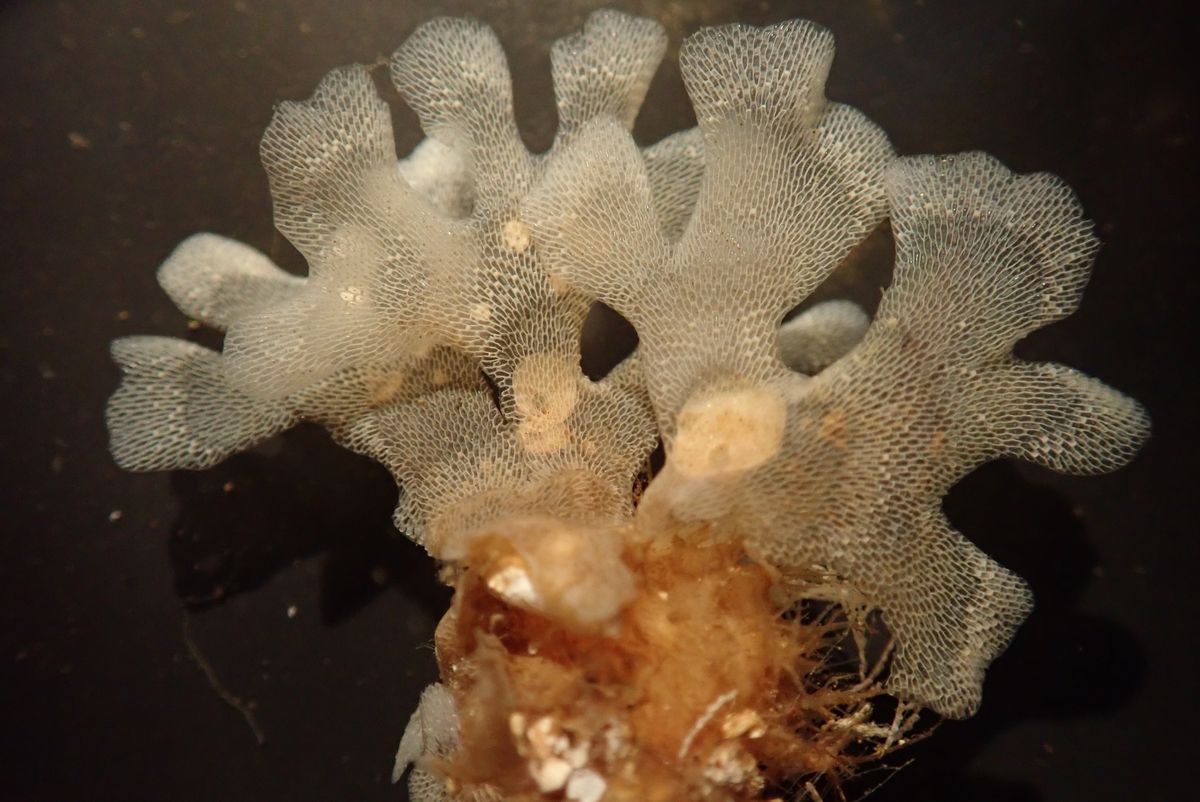ABOVE: Loxosomella nordgaardi entoprocts on the surface of a colony of Smittoidea propinqua ectoprocts Dr. Natalia Shunatova, St. Petersburg State University
Lophotrochozoa is a remarkably diverse group of animals that includes mollusks, worms, and some lesser-known, peculiar creatures. The evolutionary relationships among some of the phyla within this group are still subject to debate. This is the case for three phyla of tiny suspension feeders (Ectoprocta, Entoprocta, and Cycliophora), which have previously jumped back and forth in the lophotrochozoan tree, depending on the data and methods used to assemble it.
A new study published last week (July 1) in Science Advances proposes that all three of these phyla belong to the same clade, backing a classification that dates back to 1830 and was revived in the late 1990s. In that classification, the phyla were collectively dubbed Polyzoa. The new analysis, which includes high-quality data on gene expression in ectoprocts (also known as bryozans) and entoprocts, further suggests that the trio was one of the first to branch out from other lophotrochozoans.
Tracing back “evolutionary events that took place hundreds of millions of years ago” by studying only the few extant lineages today is a “huge challenge,” says University of Copenhagen zoologist Katrine Worsaae, who was not involved in the study. “Some of these events took place relatively rapidly within evolutionary time,” she adds, which further complicates matters.
In addition to those factors, “there is still a lot to improve” on how we infer these relationships, she notes—for instance, the quality of the data used to construct such phylogenies is not always a priority. In the new study, the authors did “the hard work of getting better and more data, which . . . is essentially the most important thing,” she says, adding that many more high-quality genomes need to be gathered to further understand the evolution of animals.

Ectoprocta and Entoprocta, once considered the same group, Polyzoa, were separated when zoologists found that the anus was located outside the tentacle crown in ectoprocts and inside it in entoprocts. Then came the 1995 discovery of Cycliophora, a phylum that so far includes only two described microscopic species living in the mouthparts of lobsters. Cycliophora was soon hypothesized to be closely related to ectoprocts and entoprocts, and with that, the Polyzoa concept was resurrected, now grouping the three phyla. However, with the advent of molecular analysis, these phyla have been shuffled around in the lophotrochozoan tree, sometimes grouped together and sometimes split, depending on the phylogenetic methods used and the species included.
Konstantin Khalturin, a molecular biologist at the Okinawa Institute of Science and Technology and coauthor of the new study, says that one of the reasons scientists arrived at various conflicting trees in past studies is because they constructed them with low-quality sequences. As he and his colleagues were especially interested in the evolutionary position of these phyla, he says they invested a lot of effort in collecting samples from Ectoprocta and Entoprocta and sequenced their transcriptomes until the team “reached really high-quality datasets.”
The team used transcriptomic data rather than genome sequencing as the latter was not of sufficient quality to perform the analysis, Khalturin explains. For instance, entoprocts have very large genomes but are very small, making it difficult to extract enough DNA to assemble a complete genome, he says.
Even obtaining sufficient material to extract and sequence the RNA of these tiny organisms is difficult for a few reasons. First, “they just eat everything which is suspended in the water,” so their guts contain all kinds of different organisms, says Saint Petersburg State University evolutionary morphologist Natalia Shunatova, a coauthor of the study who collected hundreds of these animals in the Kandalaksha Bay of the White Sea in Russia. She solved that challenge by keeping the animals in filtered seawater for a day to empty their guts.
The size of the organisms studied and sequenced in the study, which range from 200 to about 1,000 micrometers, further complicated the collection, adds Shunatova. As they are sessile, they live attached to rocks and other organisms, and “when you try to pick them up, you obviously pick up some other animals sitting close to them,” she says. To prevent contamination, the scientists only analyzed the parts of individuals and colonies that were not in contact with a substrate.
The team sequenced the transcriptomes of six species: four entoprocts and two ectoprocts, and from them generated the animals’ proteomes, obtaining a fairly complete set of proteins relevant for the comparison. For five species, they were able to infer the sequences of more than 96 percent of genes expected to be conserved in most animals according to the BUSCO database, compared to values ranging from 20 to 60 percent for both phyla in previous analyses. To construct the evolutionary history of the taxa, the authors added three more ectoprocts and one representative of Cycliophora—previously sequenced by other teams—for a total of ten species from the three phyla of interest, which they compared with data from 13 other lophotrochozoans and 14 other animal species.

Overall, the trees generated from a series of phylogenetic analyses using these data supported an arrangement where these three phyla were grouped together, in accordance with the existence of the Polyzoa group. Moreover, in most of the resulting topologies, this group appeared as the earliest branch among all other lophotrochozoan phyla.
Worsaee notes that the analysis misses some microscopic animal phyla that are closely related to Lophotrochozoa—according to various studies, lophotrochozoans are only a subset of a larger clade. These microscopic species may “actually represent even earlier lineages” within this broader taxonomic group, she adds, so without including them, it is difficult to conclude that Polyzoa is the earliest branch among all related phyla that share the same common ancestor.
Khalturin explains that he and his colleagues only used genomes or transcriptomes that were equally good as those they obtained for Ectoprocta and Entoprocta, which indeed limited the number of species in their analysis. Thus, he acknowledges that their findings are not the “final word.” Khalturin and Shunatova emphasize the need for more high-quality data from all other lophotrochozoan phyla. When more complete genetic datasets become available, “one can revisit this question and check once again,” Khalturin remarks.
Ferdinand Marlétaz, an evolutionary genomicist at University College London who did not participate in the study but has collaborated with one of the authors, agrees that “there are a lot of taxa that play a very important role” that are not present in the analysis. The authors chose to “maximize the dataset completeness” for included species, which is valid and offers an interesting output, he says. But he adds that it comes with limitations, as the absence of other groups may affect the resulting topologies.
Overall, the results of this new analysis reopen the debate on the phylogeny of lophotrochozoans, says Marlétaz, and, he predicts, “will probably trigger a new wave of studies in this area.”






